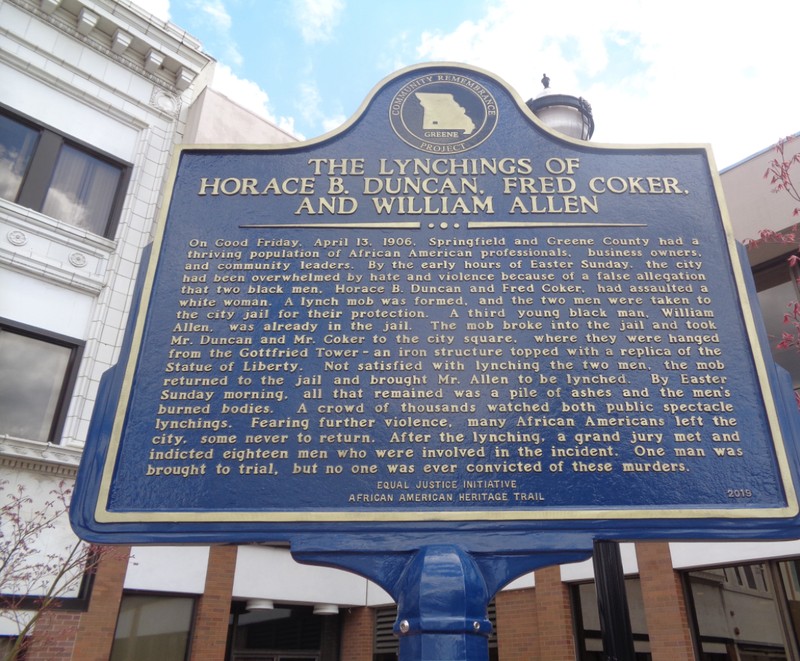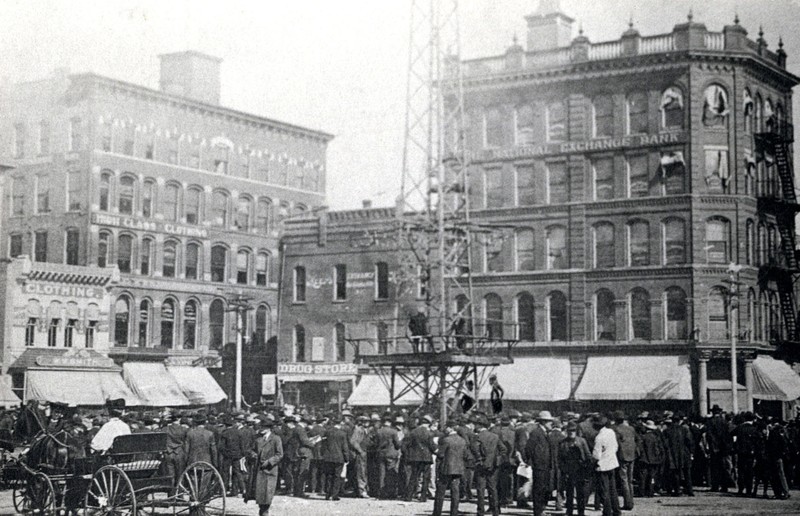Lynching of Horace B. Duncan, Fred Coker and William Allen
Introduction
Text-to-speech Audio
Dedicated in 2019 with the support of the Equal Justice Initiative, this historical marker commemorates one of the most tragic incidents in Springfield's history. On the night of April 14, 1906, a white mob lynched three African American men, Horace B. Duncan, Fred Coker, and William Allen, from a light tower that once stood here in Park Central Square. Coker and Duncan were falsely accused of assaulting a white woman the night before and were arrested and taken to the county jail. Allen was already there on an unrelated charge. The mob broke into the jail, seized Coker and Duncan, and hung them from the tower. Apparently unsatisfied, the mob returned to the jail in the early morning hours and brought Allen to the square and hung him. All three bodies were burned. Local law enforcement did little to stop the mob during the night. Although 18 men were indicted for the murders and one was tried, none were convicted. A significant portion of the African American population left Springfield after the lynchings.
Images
On the night of April 14, 1906, a white mob lynched three African-American men, two of whom were falsely accused of assaulting a white woman, from an iron tower that once stood in Park Central Square. This historical marker commemorates the incident.

This image shows a crowd at the base of the tower with two lynching victims drawn onto the picture.

Backstory and Context
Text-to-speech Audio
By 1906, the number of African-American residents in Springfield had grown to 2,300, which was about 10-15% of the city's population. It was a vibrant middle-class community of educated professionals including business owners, doctors and lawyers. However, racial tension increased in early 1906 after accounts about the murders of white men by Black men were reported in the press. One of these involved Allen and another Black man, Bus Cane, who were accused of fatally shooting a white man by the name of O.M. Rouark on the Springfield College campus on January 11. Both men left Springfield after the murder but were eventually arrested and sent to Springfield to await trial after they were implicated in the incident. Allen was about 25 years old at the time.
Coker and Duncan were good friends and worked at the same livery business. Coker was 21 and Duncan was 20. On the night of April 13th, a white woman, Mina Edwards, and a white man, Charles Cooper, were walking in west Springfield when they were attacked by two masked men. Cooper was knocked unconscious and Edwards was assaulted. Cooper later identified Duncan as one of them and the police arrested him as well as Coker since the two were together that evening. However, their employer confirmed they were working at the time of the incident. The charges were dropped and they were released but only briefly, since Cooper accused them of stealing money and personal belongings. As a result, Coker and Duncan were arrested again on charges of theft and placed in jail.
The next day, word of the alleged assault spread and in the afternoon there were rumors that a mob was forming. Apparently police officers investigated the rumors but didn't find evidence for it (it is possible they ignored or were indifferent to the rumors). But in the early evening the mob began to form in the public square and eventually made its way to the jail. The sheriff locked the jail doors and put the keys in a safe, then asked for help from men in the crowd to protect the jail. Some volunteered but it was too late. The mob stormed the building using tools including hammers and sledgehammers. They ransacked the building and the sheriff's office, and broke into Coker's and Duncan's cells. The sheriff did call for help from the city jail but no one came.
When the mob returned to the square, it made a fire at the base of the tower and lynched both men then burned their bodies. Around two hours later, the mob, still seeking vengeance, decided to go back to the jail. The jail was so damaged that Cane and some other prisoners were able to escape but Allen's cell door remained intact. The mob brought Allen to the square and hung him.
The next day, which was Easter Sunday, the men's burned bodies were still at the base of the tower. White families, many wearing church clothes, came to the square to see what remained. Remnants of the incident—pieces of the hangman's rope, ashes, and charred remains of the men—were collected and even sold as souvenirs. The governor called in the state militia to restore order in Springfield on the 15th and 16th. The remains of the three men were buried in a single casket in Hazelwood Cemetery on the 17th. Mina Edwards and Charles Cooper left Springfield and it is unclear what happened to them. Many in the African-American community remained in their homes out of fear and, as noted above, many left Springfield for good.
A grand jury's report released five weeks later condemned the lynchings and stated that it was unlikely that Edwards and Cooper were assaulted. The report also stated that Coker and Horace were innocent, and that local law enforcement were grossly negligent in performing their duties. All 18 men indicted for the lynchings were were eventually acquitted. This failure to hold whites accountable for crimes committed against Blacks was all too common in the country for decades. Between 1877 and 1950, around 4,000 Black Americans were lynched, including at least 60 in Missouri.
Sources
"Horace Duncan and Fred Coker, April 14 and William Allen, April 15, 1906 Springfield, Greene County." Community Remembrance Project. Accessed May 13, 2022. https://crp-mo.org/greene-county-coalition.
"Lynching in America / The Lynchings of Horace B. Duncan, Fred Coker and William Allen." The Historical Marker Database. Accessed May 13, 2022. https://www.hmdb.org/m.asp?m=173592.
Skalicky, Michele. "Lynching of 3 young Black men on Park Central Square in 1906 is a tragic part of Springfield's history." KSMU Ozarks Public Radios. December 14, 2021. https://www.ksmu.org/show/sense-of-community/2021-12-14/lynching-of-3-young-Black-men-on-park-central-square-in-1906-is-a-tragic-part-of-springfields-history.
The Historical Marker Database
Missouri State Digital Collections: https://cdm17307.contentdm.oclc.org/digital/collection/LedererExhibit/id/219/
